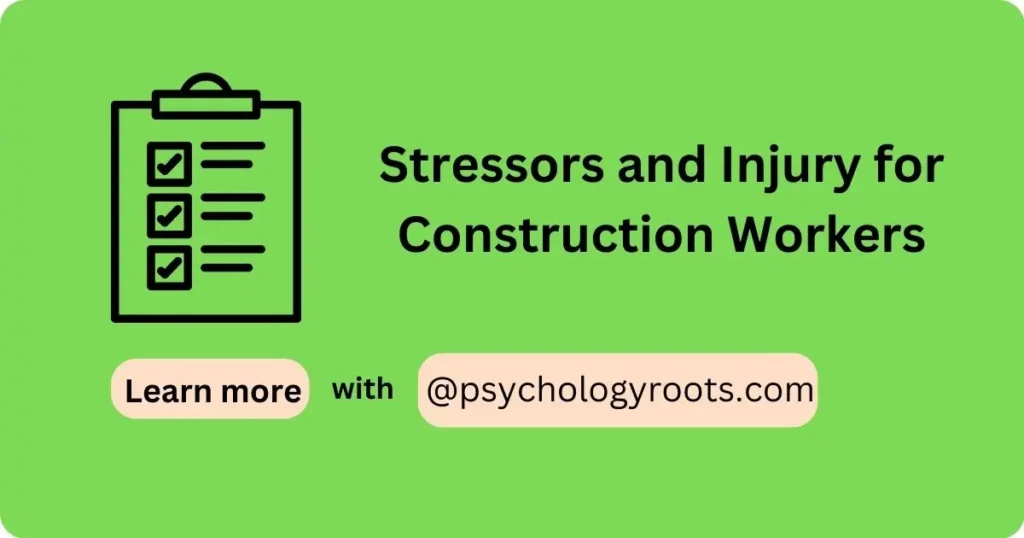Table of Contents
Stressors and Injury for Construction Workers
Here in this post, we are sharing the “Stressors and Injury for Construction Workers”. You can read psychometric and Author information. We have thousands of Scales and questionnaires in our collection (See Scales and Questionnaires). You can demand us any scale and questionnaires related to psychology through our community, and we will provide you with a short time. Keep visiting Psychology Roots.
About Scale Name
Scale Name
Stressors and Injury for Construction Workers
Author Details
Goldenhar, L. M., Williams, L. J., and Swanson, N. G
Translation Availability
Not Sure

Background/Description
The stressors and injury questionnaire for construction workers was developed by Goldenhar, Williams, and Swanson in 2003. The purpose of the questionnaire is to assess the relationship between self-reported job-task demands, organizational stressors, psychological and physical symptoms, and injuries or near miss incidents at work.
The questionnaire contains 47 items that elicit information on the respondent’s job-task demands, exposure to, or protection from, work-related stressors, organizational stressors that they may encounter, as well as their psychological and physical symptoms, injuries, and near-miss incidents.
The questionnaire is based on a stress-injury model and has been used to test whether work stressors could be related, either directly or indirectly through the mediating effects of physical or psychological symptoms/strain, to self-reported injuries or near miss incidents. The construction industry is known to be a high-risk industry for work-related injuries, making this questionnaire particularly relevant in this context.
By identifying potential stressors and their effects on workers, measures can be taken to reduce or prevent injuries and near misses, ultimately creating a safer working environment for construction workers.
Administration, Scoring and Interpretation
N/A
Reliability and Validity
N/A
Available Versions
47-Items
Reference
Goldenhar, L. M., Williams, L. J., & Swanson, N. G. (2003). Modelling relationships between job stressors and injury and near-miss outcomes for construction labourers. Work & Stress, 17(3), 218-240.
Important Link
Scale File:
Frequently Asked Questions
What are some common stressors for construction workers?
Some common stressors for construction workers include heavy physical demands, time pressures, long work hours, job insecurity, and exposure to hazardous materials and conditions.
How can stress affect the physical health of construction workers?
Chronic stress can lead to physical health problems such as high blood pressure, heart disease, and musculoskeletal disorders. Stress can also weaken the immune system, making workers more susceptible to illness and injury.
How can stress affect the mental health of construction workers?
Stress can lead to mental health problems such as anxiety and depression, which can have a negative impact on workers’ personal and professional lives. It can also contribute to substance abuse and addiction.
What can employers do to reduce stress and prevent injuries in the construction industry?
Employers can take several steps to reduce stress and prevent injuries in the construction industry, such as providing regular safety training, implementing safety protocols and procedures, providing adequate resources and equipment, promoting a culture of safety, and offering support services for workers experiencing stress or mental health issues.
How can workers cope with stress in the construction industry?
Workers can cope with stress by engaging in regular physical activity, getting adequate rest and nutrition, practicing relaxation techniques such as deep breathing and meditation, seeking social support from friends and family, and seeking professional help if needed.
What is the relationship between stress and injury in the construction industry?
Research suggests that stress can increase the risk of injury in the construction industry, either directly or indirectly through the mediating effects of physical or psychological symptoms/strain. Identifying potential stressors and addressing them can help reduce the risk of injury and create a safer working environment for construction workers.
Disclaimer
Please note that Psychology Roots does not have the right to grant permission for the use of any psychological scales or assessments listed on its website. To use any scale or assessment, you must obtain permission directly from the author or translator of the tool. Psychology Roots provides information about various tools and their administration procedures, but it is your responsibility to obtain proper permissions before using any scale or assessment. If you need further information about an author’s contact details, please submit a query to the Psychology Roots team.
Help Us Improve This Article
Have you discovered an inaccuracy? We put out great effort to give accurate and scientifically trustworthy information to our readers. Please notify us if you discover any typographical or grammatical errors.
Make a comment. We acknowledge and appreciate your efforts.
If you have any scale or any material related to psychology kindly share it with us at psychologyroots@gmail.com. We help others on behalf of you.